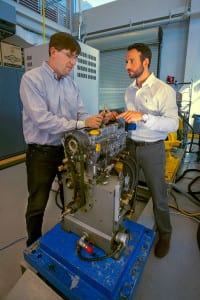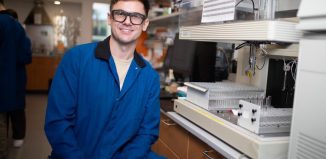The one who grew up in Greece specializes in working on computers, where he plugs numbers into a model, runs simulated tests and generates information. His collaborator, who was raised near Boston, works with physical models, testing, tinkering and changing objects in real life.

Together, these two mechanical engineers who work at Stony Brook, recently won a $1 million grant from the U.S. Department of Energy to develop and test a patented design they hope improves the efficiency and reduces the emissions of car engines.
“The heart of what we do,” said Benjamin Lawler, an assistant professor in mechanical engineering, speaking broadly about his research interests, “is to look at the way our society works, look for inefficiencies and look for ways we can improve upon them.”
With a proposal to work with an onboard fuel reformer, Lawler, who is originally from Swampscott, Massachusetts, and Sotirios Mamalis, who was raised in Athens, Greece, won one of eight DOE grants awarded to research teams around the country that are exploring similar ways to improve vehicle technology.
The two engineers met when they were Ph.D. students at the University of Michigan. They had the same advisor, Dennis Assanis, who is now the provost at Stony Brook and a professor in the Department of Mechanical Engineering.
Assanis said these engineers faced stiff competition against people with similar backgrounds from around the world. “They prevailed over a pool of talented applicants,” Assanis said, adding that he has “tremendous confidence in their abilities.”
Stony Brook has been building its mechanical engineering department, among others at the campus, and hopes to nearly double the number of faculty within the next five years, Assanis said. He would like mechanical engineering to be “one of our strong pillars” for academic research.
Lawler and Mamalis are looking at improving the practical application of an existing technology called Reactivity Controlled Compression Ignition. These type of engines require two different types of fuel, which limits their use.
“Concepts that use two fuels haven’t worked out well,” Assanis said.
Lawler and Mamalis are hoping to improve on the use of an onboard fuel reform system that will change the chemical composition of one type of gas into two, enabling more consumer vehicles to benefit from the RCCI technology.
An onboard fuel reformer will “take a fuel and partially react it, changing its chemical composition into a different mixture,” Lawler said.
Using funds from the grant for the next three years, Lawler and Mamalis will test conventional gas, diesel and natural gas to see if their approach to the fuel reformer can expand the application of this technology.
Mamalis said he expects, based on the literature and the properties of the parent fuels, that conventional gas will be the best candidate for the process.
Lawler and Mamalis said they face a number of hurdles to make their approach viable.
“One of the personal concerns I have is whether there’s enough difference between the parent fuel and what it gets reformed into,” Lawler said.
Assanis, who is a co-principal investigator on the grant, said there’s “very good potential” for this fuel reformer, although he, too, recognized the difficulties along the way.
“We can’t have a reformer that takes too much space and we need to keep the weight low,” Assanis said. Still, this kind of research could lead to advances in the technology. “We need to walk before we drive,” said Assanis.
If the work on this project shows some promise, and Lawler and Mamalis generate improved efficiency and lower emissions, they would likely submit more grants and, down the road, look to attract a commercial partner.
Stony Brook “wants to give back to the community” with its innovations, Assanis said. If this proves effective, the researchers could license it to others or they might form a start-up company with university investors.
In addition to the internal combustion engine work, the duo is working on a study funded by the Advanced Research Projects Agency-Energy that relates to stationary electrical power generation.
Assanis said this is one of four ARPA-E awards Stony Brook faculty have received recently, that total a combined $6.5 million.
“It’s hard to get these grants,” Assanis said. “We’ve gotten four awards at the same time in different areas. This shows you where we want to go.”
Lawler and Mamalis said they are working to learn each other’s domains, as Mamalis has improved Lawler’s knowledge of computer modeling and Mamalis is spending more time working with the machine parts in the lab.
A resident of Stony Brook, Lawler said Long Island is similar to where he grew up. The differences are more dramatic for Mamalis, who speaks Greek, English and German. Mamalis said he has a “professional opportunity to grow that he wouldn’t have in Greece,” and he appreciates the proximity to New York City.
The two assistant professors worked with one graduate student in their lab last semester. This semester, they have five graduate students.
Assanis expressed confidence in the professional collaborations of these two mechanical engineers. “They are a good partnership,” Assanis said and he sees how “well they complement each other.”






